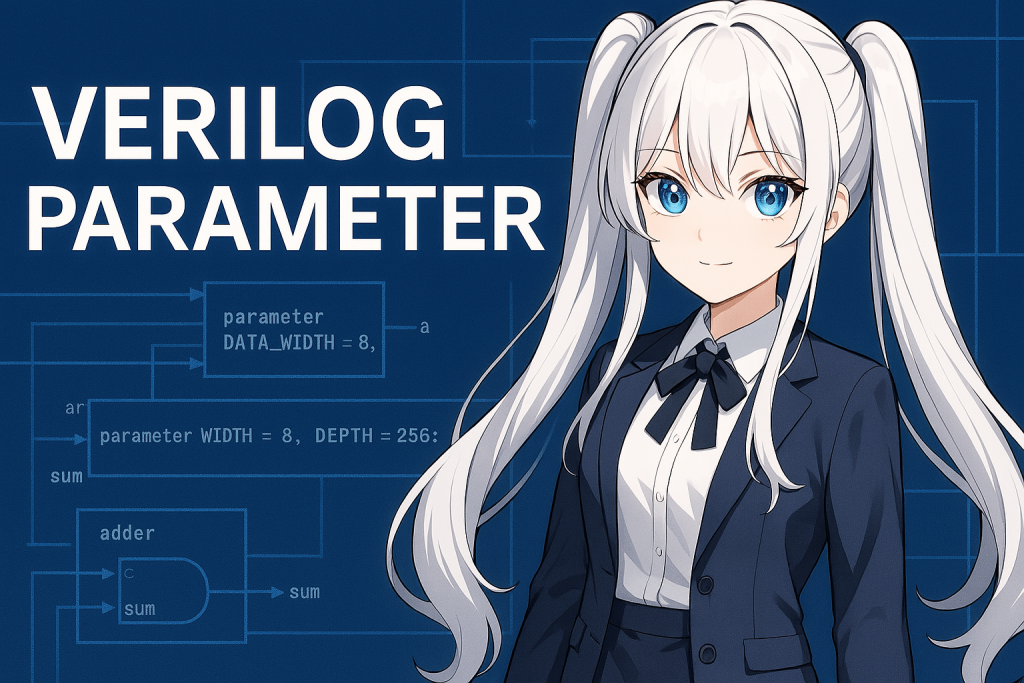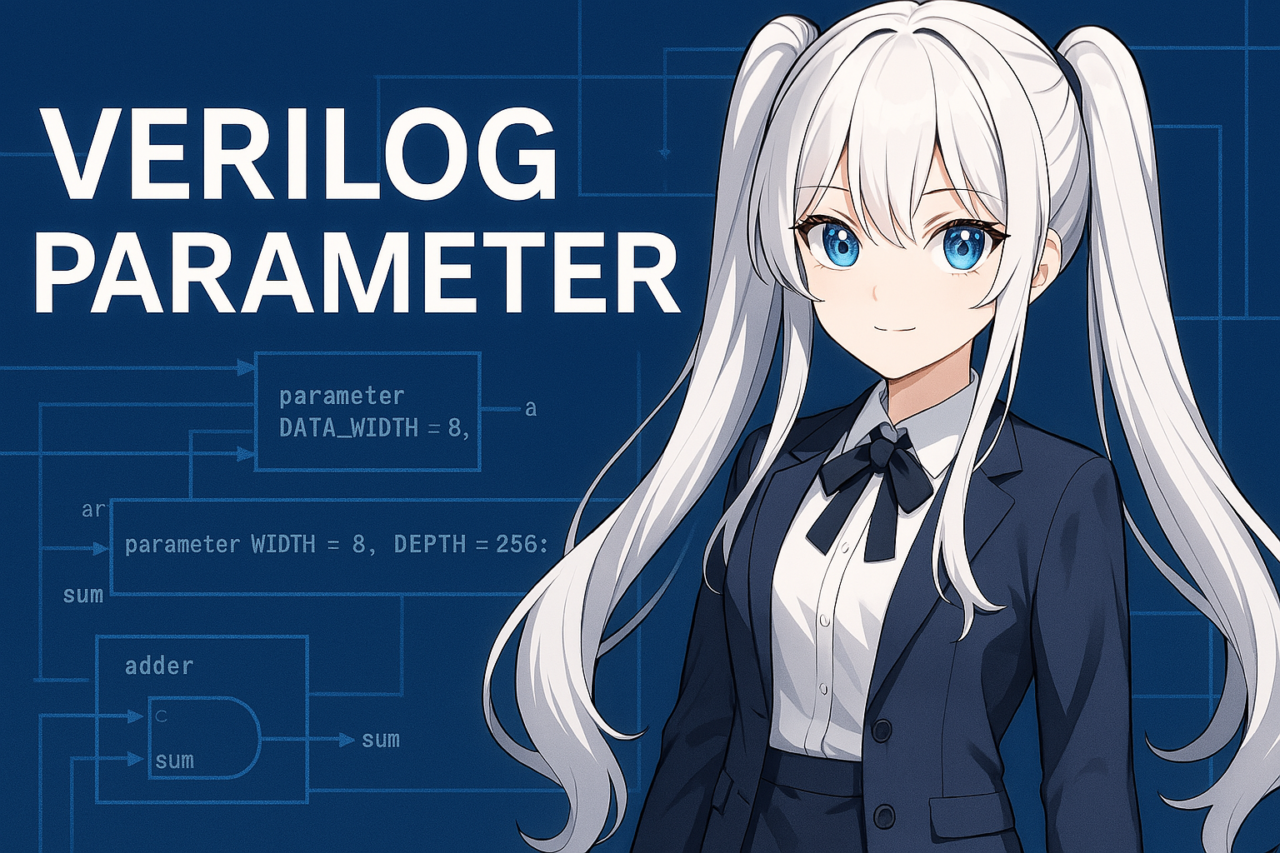目次
- 1 1. Introduction
- 2 2. Basic Syntax of parameter
- 3 3. Parameterizing Modules with parameter
- 4 4. Applications of parameter
- 5 5. Best Practices and Caveats When Using parameter
- 6 6. FAQ: Frequently Asked Questions
- 6.1 Q1. What is the difference between parameter and localparam?
- 6.2 Q2. What happens if I don’t specify the bit-width of a parameter?
- 6.3 Q3. Does parameter always have to be a constant?
- 6.4 Q4. How does changing parameter values affect FPGA implementation?
- 6.5 Q5. Can I use arithmetic or logical operations inside parameter?
- 7 7. Conclusion
1. Introduction
What is parameter in Verilog?
Verilog is one of the hardware description languages (HDL) used for digital circuit design. Among its features, parameter plays a crucial role in improving flexibility and reusability in hardware design. A parameter allows you to define constants with meaningful names, which is extremely useful when you want to reuse the same module under different configurations or improve code readability. Instead of hard-coding fixed values for circuit elements such as bit-widths, bus sizes, or timing configurations, defining them as parameters enables a more maintainable and easily modifiable code structure.Why is parameter important?
Using parameter in Verilog design provides the following benefits:- Improved reusability Modules can be reused in multiple projects, allowing efficient development even in large-scale designs.
- Better maintainability Since constants are managed in a single place, changes only require updating the corresponding
parameter. - Enhanced readability By avoiding “magic numbers” and clearly naming values, your code becomes much easier for others to understand.
parameter DATA_WIDTH = 8; and using [DATA_WIDTH-1:0] makes the design intent far clearer.What you will learn in this article
This article provides a structured explanation ofparameter in Verilog, covering both the basics and advanced usage. It is especially useful for:- Beginners just starting with Verilog
- Intermediate engineers aiming for more flexible module design
- Designers who want to improve code maintainability and readability
parameter, but also how to apply it effectively in module design and what pitfalls to avoid.2. Basic Syntax of parameter
How to declare parameter
In Verilog, a parameter is used to define constants within a module. The basic syntax is:parameter parameter_name = value;parameter DATA_WIDTH = 8;parameter can then be used like a variable throughout the module. However, keep in mind that parameter is a compile-time constant and cannot be changed during runtime.Defining multiple parameters at once
When a module requires multiple parameters, they can be defined in a single line separated by commas:parameter WIDTH = 8, DEPTH = 256;parameter WIDTH = 8;
parameter DEPTH = 256;Specifying bit-width
By default, aparameter is a 32-bit unsigned integer. However, you can explicitly specify the bit-width:parameter [7:0] INIT_VALUE = 8'hFF;INIT_VALUE is treated as an 8-bit value, which is especially important in designs involving bit-level operations.Scope and redefinition of parameter
A parameter is local to the module, meaning it cannot be directly accessed from outside. However, when instantiating a module, parameters can be overridden from a higher-level module (explained in later sections). Verilog also provides localparam, which is similar but cannot be overridden externally.
3. Parameterizing Modules with parameter
Adding flexibility to modules with parameter
parameter gives modules flexibility, allowing you to reuse the same module under different conditions. By defining specific values (such as bit-widths, array sizes, or clock cycles) as parameters, a single design can be applied to multiple use cases.Example: A parameterized adder module
The following is a simple adder example where the data width is defined usingparameter:module adder #(parameter WIDTH = 8)(
input [WIDTH-1:0] a,
input [WIDTH-1:0] b,
output [WIDTH-1:0] sum
);
assign sum = a + b;
endmoduleWIDTH at instantiation, you can use it as an adder with any desired bit-width.How to override parameters from a higher-level module
1. Using the #() syntax
When instantiating a module, you can override parameters by passing values through #(), enabling top-level modules to modify parameters.adder #(.WIDTH(16)) adder_inst (
.a(a_input),
.b(b_input),
.sum(sum_output)
);2. Using defparam (not recommended)
Another way is to use the defparam statement:defparam adder_inst.WIDTH = 16;defparam is discouraged in modern design practices because it scatters parameter definitions, reducing maintainability. For clarity and readability, the #() syntax is the preferred method.Example: Overriding multiple parameters
If a module has multiple parameters, you can override them all within#() using commas:module fifo #(parameter DATA_WIDTH = 8, DEPTH = 64)(/* ports */);
// Instantiation in top-level module
fifo #(
.DATA_WIDTH(16),
.DEPTH(128)
) fifo_inst (
/* connections */
);4. Applications of parameter
parameter is more than just a constant replacement — it offers a wide range of practical applications in Verilog design. In this section, we’ll look at real-world use cases that demonstrate advanced ways to leverage parameters.Making bit-widths and bus sizes configurable
In digital circuit design, being able to change bit-widths flexibly is extremely valuable. This is especially true for datapath and bus designs, where requirements often change later in the project.module register #(parameter WIDTH = 8)(
input wire clk,
input wire [WIDTH-1:0] d,
output reg [WIDTH-1:0] q
);
always @(posedge clk)
q <= d;
endmoduleWIDTH can be adjusted to handle 8-bit, 16-bit, 32-bit, or other configurations using the same module design.Centralized management of design values for readability and maintainability
When constants are used across multiple modules or files,parameter enables centralized definition and modification.
Example:parameter CLK_DIV = 100;always @(posedge clk)
if (counter == CLK_DIV)
clk_out <= ~clk_out;100 and makes the design more understandable.Controlling structural repetition with generate
When combined with generate, parameters allow flexible control of structural repetition. For example, generating N registers can be written as:module shift_reg #(parameter STAGES = 4)(
input wire clk,
input wire in,
output wire out
);
reg [STAGES-1:0] shift;
always @(posedge clk)
shift <= {shift[STAGES-2:0], in};
assign out = shift[STAGES-1];
endmoduleSTAGES value, you can create a shift register of any length, enabling resource-efficient and scalable hardware design.Using parameters in testbenches
Parameters are also powerful in testbenches, allowing centralized test conditions and easy switching between multiple scenarios.module testbench;
parameter DATA_WIDTH = 16;
reg [DATA_WIDTH-1:0] a, b;
wire [DATA_WIDTH-1:0] result;
adder #(.WIDTH(DATA_WIDTH)) dut (
.a(a),
.b(b),
.sum(result)
);
// Test logic...
endmoduleDATA_WIDTH once and validate behavior across different bit-widths with minimal effort.5. Best Practices and Caveats When Using parameter
While parameter is extremely useful, improper usage can cause unexpected behavior or design errors. This section highlights common pitfalls to watch out for.Always specify bit-width explicitly
In Verilog, aparameter is interpreted as a 32-bit unsigned integer by default. For simple constants this may not cause issues, but when used in bit operations or slicing, explicit bit-width specification is essential.parameter [7:0] INIT_VAL = 8'hFF; // Explicitly defined as 8-bitUnderstand the difference between parameter and localparam
Verilog provides localparam, which is similar to parameter but cannot be overridden from outside the module.| Type | Can be overridden from parent module? | Use case |
|---|---|---|
parameter | Yes | Values that need to be configurable externally |
localparam | No | Fixed internal constants within a module |
module example #(parameter WIDTH = 8) ();
localparam HALF_WIDTH = WIDTH / 2;
endmodulelocalparam is ideal for helper values or intermediate constants that should not be modified externally.Redefinition and hierarchy issues
As module hierarchies grow, it can become unclear whichparameter value is being applied. Using the same parameter name with different values across instances can lead to unintended behavior.- Adopt clear naming conventions (e.g.,
FIFO_DEPTH,ALU_WIDTH). - Be mindful of parameter scope within each module.
Be aware of synthesis tool limitations
Different synthesis tools and simulators may have different restrictions or interpretations when handling parameters. Points to note include:- Arithmetic operations on parameters with explicit bit-widths may behave differently across tools.
- Signed vs. unsigned interpretation may vary.
defparamis often deprecated or unsupported in modern tools.
6. FAQ: Frequently Asked Questions
Here are some common questions engineers (from beginners to intermediate) often ask about Verilogparameter. These address practical issues frequently encountered in both learning and design environments.Q1. What is the difference between parameter and localparam?
A1. A parameter is a constant that can be overridden from a parent module, whereas localparam is a fixed constant valid only within the module.parameter: Flexible, but must be handled carefully to avoid unintended overrides.localparam: Suitable for internal constants that should not be modified externally.
- Want module reusability → use
parameter - Need fixed values for design stability → use
localparam
Q2. What happens if I don’t specify the bit-width of a parameter?
A2. If no bit-width is specified, Verilog treats a parameter as a 32-bit unsigned integer by default:parameter WIDTH = 8; // Actually 32-bit wideparameter [7:0] WIDTH = 8;Q3. Does parameter always have to be a constant?
A3. Yes. parameter must be a constant value determined at compile time. It cannot be assigned to variables or runtime signals. ❌ Invalid example:input [7:0] a;
parameter WIDTH = a; // Errorparameter WIDTH = 8;Q4. How does changing parameter values affect FPGA implementation?
A4. Changing a parameter directly changes the synthesized circuit structure.
For instance, modifying the bit-width of an adder not only changes functionality but also affects resource usage and timing. This is a powerful feature of Verilog, but without thorough testing, it can lead to unexpected circuit behavior.Q5. Can I use arithmetic or logical operations inside parameter?
A5. Yes. Since parameter is evaluated at compile time, arithmetic (add, subtract, multiply, divide) and logical (AND, OR, NOT) operations are allowed:parameter WIDTH = 8;
parameter HALF_WIDTH = WIDTH / 2;7. Conclusion
In Verilog,parameter is an essential feature that enables flexible and reusable hardware design. This article has provided a systematic explanation from the basics to advanced usage.Key takeaways
parameterdefines constants within a module, greatly improving design reusability and maintainability.- By using the
#()syntax at instantiation, parameters can be dynamically overridden from parent modules. - When combined with
generate, structural repetition and conditional design can be controlled flexibly. - Be mindful of bit-width specification, the difference between
localparamandparameter, and tool-dependent behaviors. - The FAQ covered common misunderstandings and design pitfalls.
Final thoughts
Whether you can useparameter effectively in Verilog module design has a direct impact on code scalability and overall quality.
Beginners should start by getting comfortable with basic usage, then gradually expand into advanced applications for smarter, more maintainable designs. As your projects grow in complexity, leveraging parameter will allow you to “reuse by reconfiguring” rather than “rebuilding from scratch”, making development faster and more efficient.



